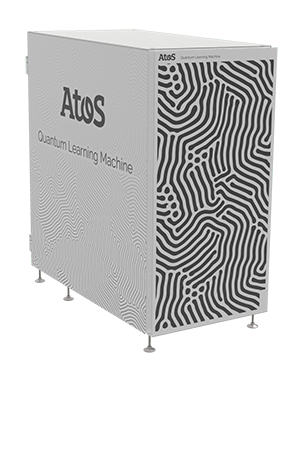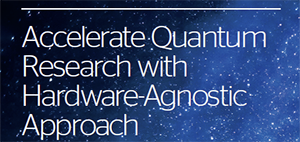Quantum computing, an emerging technology, harnesses the power of quantum mechanics to tackle incredibly complex problems beyond the reach of conventional computers.
The rise of quantum computers promises to dramatically boost computing power, enabling the simulation of intricate systems in mere seconds—a feat that would take traditional supercomputers thousands of years.
Quantum computing revolutionizes digital potential for organizations across various fields, including molecular dynamics, physics, pharmaceuticals, autonomous vehicles, supply chains, financial services, and cybersecurity, to name a few.
IDC predicts that
worldwide customer
spending for
quantum computing
will grow to
$8.6 billion in 2027.
Get ready for the Quantum revolution!
Quantum is opening possibilities that will transform how information is processed and used. Thanks to Atos quantum solutions, you can start experimenting and developing applications.
![]()
Discover Atos’ Quantum Learning Machine (QLM), a comprehensive programming development platform and the world’s highest-performing quantum simulator.
Available in many countries, Atos QLM enhances and accelerates research programs across a variety of sectors, providing customers with unparalleled capabilities for exploring and developing quantum solutions.
![]()
Test and develop quantum algorithms on any device with myQLM, a freeware Python package which comes with interoperability connectors.
This package allows for easy integration and collaboration with other tools and systems, making it a versatile and accessible solution for working with quantum computing applications.
![]()
Accelerate quantum applications in life with Q-score, a groundbreaking quantum metrics reference applicable to all quantum processors.
This innovative metric measures the efficiency of executing representative quantum applications, focusing on a system’s effectiveness in tackling real-life problems rather than its theoretical or physical performance.
![]()
Experience top-notch consulting and innovation services tailored to help you understand, evaluate, identify real use cases, and adopt cutting-edge technology.
Stand out from the competition by leveraging unique expertise in the field of quantum hybridization – the convergence of high-performance computing (HPC) and quantum computing.
Introducing Qaptiva™
![]()
Through Qaptiva™, we enable enterprises and institutions to anticipate the availability of advanced quantum computers and implement real-world use cases to enhance their discovery capabilities and tackle intricate business problems by harnessing innovation through quantum computing technology.
QLM
The Atos Quantum Learning Machine (QLM) is a complete on-premises environment with a powerful dedicated hardware infrastructure that allows researchers, engineers, and students to develop and experiment with quantum software.
It embeds a programming platform, high-performance quantum simulators, and optimizers. As a result, applications developed on the Atos QLM can be emulated or run on quantum accelerators without changing a single line of code.
The QLM software simulates physical noise for a closer-to-reality hardware quantum environment sensitive to different physics effects. It provides predefined models that allow tuning to simulate specific hardware, and it also allows advanced users to define noisy gates to get better-suited noisy simulation results.

Core benefits
Universal programming environment
- Supports the most widely used quantum programming paradigms (gate-based, annealing, and analog)
- Built to evade hardware lock-in
Provides scalability
- 41 qubits (brute force simulation)
- Hybrid quantum-classical simulations
Provides a user-friendly framework
- Jupyter Notebooks library
- Integrated Quantum Algorithms & QLIB
Offers interoperability
- Interoperability capabilities with proprietary frameworks
- Enables the development of custom connectors
Provides advanced simulation
- Evaluate the impact of quantum noise on your simulation’s results
Accelerates supercomputers and hybrid systems
- Enables the design of new quantum-powered accelerators for supercomputers or hybrid systems
QLM E
Quantum Learning Machine Enhanced – QLM E – is a new range of GPU-accelerated Quantum Learning Machine. QLM E offers an acceleration up to 12 times to simulate variational algorithms that a particularly well-suited for NISQ (Noisy Intermediate Scale Quantum) devices, which will be the first quantum accelerators to be commercialized in the next few years.
By promising to apply, in the near-term, computation capabilities that are beyond the reach of even the most powerful existing computers to solve complex, real-life problems, NISQ devices will play an important role in determining the commercial potential of quantum computing. Herein lies a double challenge for the industry: developing NISQ algorithms is as important as building the machines, since both are required to identify concrete applications. QLM E has been optimized to drastically reduce the compilation time of hybrid quantum-classical algorithms simulations, leading to quicker advancement in application research.
QLM E[nhanced] accelerating research in the NISQ era
- Accelerate your quantum simulations up to 12x
- Optimized for variational algorithms best suited for the NISQ* era (up to 30 qubits)
- Upgrade your QLM to a QLM E very easily to benefit from these enhanced features
Accelerate research on variational algorithms using QLM E:
- Quantum Approximate Optimization Algorithm
- Variational Quantum Eigensolver / Variational Imaginary Time Evolution
- Variational Quantum Factoring
- Variational Quantum Classifier
Combinatorial Optimization
Atos’ QLM for Combinatorial Optimization environment will allow users to prepare codes to tackle combinatorial optimization problems using either quantum annealing or gate-based quantum computing.
As an additional feature of the Atos Quantum Learning Machine (QLM), Atos then allows users to simulate their code either on noisy or noiseless digital quantum simulators or using quantum-inspired modules like Simulated Quantum Annealing (SQA) or Simulated Bifurcation Algorithm (SBA).
Quantum Computing promises to solve larger optimization problems faster and more accurately, which will generate tangible benefits for industries, such as portfolio management, logistics, antenna location, chip design or clinical trial database search.
Key benefits of using both approaches in the Atos QLM

Better understand the specificities of quantum annealing and digital quantum computing
Compare the benefits and constraints of two quantum computing technological paths applied to combinatorial optimization problems
Prepare code to then run on NISQ accelerators or Quantum Annealing machines using the same programming environment
Join the Quantum revolution with our experts
Atos provides a broad range of consulting and integration services that leverage QLM intuitive programming environment.
Our quantum experts accompany you at every step of our journey, from the discovery of the QLM appliance to the development and simulation of your first quantum codes.
Our methodology is structured around a few simple but proven steps to ensure that our world-class quantum experts understand your goals, deliver the desired outcomes, and ensure that you have a clear plan on how you will proceed.
- Quantum computing programming basis: A comprehensive approach to quantum computing. A half-day session for beginners.
- Atos QLM Fast Start: Quick knowledge ramp-up on the Atos QLM appliance. 2-day sessions for intermediate.
- Decoding of quantum algorithms: Principles and building steps of specific quantum algorithms. 2-day sessions for advanced.
- Proof of concept: Study the feasibility of quantum implementation relative to the real use cases. 5 days to 8 months for business and experts.
Atos launched the Quantum Advisory Board to assess the evolution of the market and to discuss and advance Atos’ quantum strategy.
The 9th Quantum Advisory Board edition was held on Friday, December 2, 2022.
The Advisory Board is composed of a group of international experts, mathematicians, and physicists, including two Nobel Prizes, and authorities in their fields.
- Alain Aspect, Professor at the Institut d’Optique Graduate School, Université Paris-Saclay and at Ecole Polytechnique, Institut Polytechnique de Paris, Nobel Laureate 2022 in Physics
- David DiVincenzo, Director of the Institute for Theoretical Nanoelectronics at the Juelich Research Center and Professor of Physics at RWTH Aachen University;
- Artur Ekert, Professor of Quantum Physics at the Mathematical Institute, University of Oxford and Founding Director of the Centre for Quantum Technologies in Singapore;
- Daniel Esteve, Research Director, CEA Saclay, Head of Quantronics;
- Serge Haroche, Professor emeritus at the Collège de France, Nobel Laureate 2012 in Physics.
Fast Start program with the Center of Excellence in advanced computing
- Discover the QLM
- Develop & Simulate your codes
- AQASM & pyAQASM
- Compile & Execute your algorithms…
- During two days
- On your premises
The Atos QLM User Club is an independent world-wide group of users that aims at exchanging on the future of computing, emerging technologies, new quantum algorithms and quantum programming best practices.
Atos Center for Excellence in Performance Programming (CEPP) helps you get optimal performance and maximum energy efficiency.
Already widely adopted
Thanks to its scalability, openness and unrivalled power, Atos Quantum Learning Machine is already adopted by major quantum players:
- CESGA – Galician Supercomputing Center
- Intelligent Wave Inc. (Japan)
- CSC – IT Center for Science (Finland)
- C-DAC (India)
- TotalEnergies (France)
- STFC Hartree Centre (UK)
- Argonne National Laboratory (USA)
- FH Upper Austria (Austria)
- CEA – Atomic Energy Commission (France)
- Oak Ridge National Laboratory (USA)
- CNCS – Centre National de Calcul Scientifique (Senegal)
- Bayer (Germany)
- Forschungszentrum Jülich (Germany)
- Université de Reims Champagne-Ardennes (URCA) – (France)
From a disruptive innovation to a commercial success
They chose the Atos Quantum approach

From disruptive innovation to commercial success,
they chose the Atos Quantum approach

Related resources
Press releases
May 11, 2023
Eviden takes quantum computing application development to the next level with its new Qaptiva offering
November 16, 2022
Atos and IQM partner up in quantum simulation
Atos and Aspen Systems form reseller alliance to power HPC and quantum market in North America
June 9, 2022





